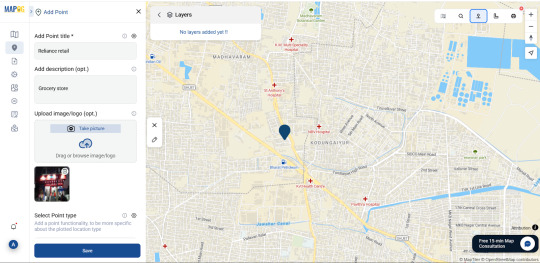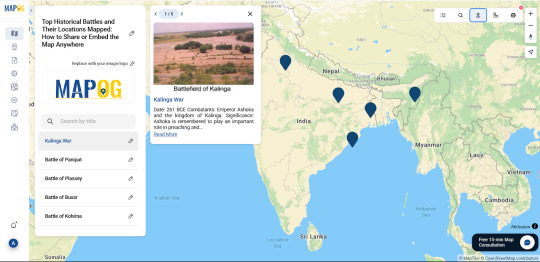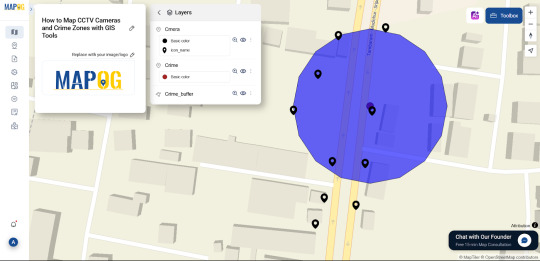Don't wanna be here? Send us removal request.
Text
How to Map, Share, and Embed Your Retail Business Locations
India’s retail revolution is not just happening online—it’s visible in bustling high streets, quiet neighborhoods, and fast-growing urban zones. Whether you run a chain of organic stores, local fashion outlets, or mobile service centers, each business location is a story—a physical point where customer experience begins. Mapping these sites digitally turns your retail network into an interactive brand journey that informs, attracts, and engages. Exploring Your Retail Footprint

Every store, kiosk, or service outlet is more than a dot on a street—it represents a customer relationship, a brand touchpoint, and a growth strategy. From flagship stores in metros to pop-ups in Tier-II towns, mapping retail locations helps showcase not just where your business is—but how it’s growing.
Whether you're managing 3 stores or 300, mapping helps identify trends in footfall, highlight premium outlets, and guide customers efficiently. It also supports hyperlocal marketing, logistics planning, and franchise development.
Bringing Retail Visibility to Life Through Digital Maps
In a world where search and discovery are digital, your customers expect more than a static address. That’s where platforms like MAPOG step in—enabling businesses to create rich, interactive, and user-friendly maps. You can place each store location on a dynamic map, and include:
Store hours, contact details, links to directions
Interior/exterior photos
Special offers or events
Customer ratings or testimonials
Service availability (pickup, delivery, in-store shopping)
This geo-visual approach transforms your retail presence into a customer-centric digital experience.

Who Benefits from Mapping Retail Locations?
Mapping your retail network is a game-changer for:
Small business owners wanting hyperlocal discoverability
Retail chains/franchises managing expansion and customer service
Marketers and brand teams tracking regional campaigns or activations
Customers looking for the nearest store, availability, or latest offers
Logistics teams optimizing delivery and supply chains
Whether you're offering healthcare services, groceries, apparel, or electronics—mapped visibility leads to walk-ins, trust, and conversion.
Conclusion
Platforms like MAPOG empower retail businesses to visually and strategically showcase their footprint. It's no longer just about a store’s location—it’s about context, experience, and connection. Whether you're starting out or scaling up, an interactive map is your visual gateway to customer discovery and brand loyalty.
Have you tried mapping your retail network yet? Share your map, ideas, or questions in the comments—and help others discover your journey.
0 notes
Text
Top Historical Battles and Their Locations Mapped: How to Share or Embed the Map Anywhere India’s military history is deeply woven into the story of its civilization—each battlefield a witness to shifting empires, valiant resistance, and transformative victories. From the epic Battle of Kurukshetra to strategic colonial-era clashes like Plassey and Buxar, these historic events shaped the nation's identity. Long before modern warfare, these battles were fought with valor, strategy, and sometimes sacrifice, leaving a legacy that still resonates today.

Exploring India’s Historic Battlefields
India’s landscape is dotted with the sites of legendary confrontations—Panipat, Haldighati, Talikota—each carrying the weight of history. These were more than just places of conflict; they were turning points that altered political and cultural trajectories. Whether between kingdoms or against colonial forces, each battle had far-reaching consequences, making their locations significant markers on the timeline of Indian history.
Bringing History to Life Through Digital Maps
In a time where education meets technology, digital mapping offers a unique way to interact with history. Using platforms like MAPOG, you can create an immersive and interactive experience by placing these key battle locations on a map. This spatial approach allows users to explore how historical conflicts unfolded across regions, connecting the dots in both geography and context.

Customize, Connect, and Create a Visual Timeline
With tools that let you add detailed notes, historical images, and paths showing troop movements or strategic routes, platforms like MAPOG go beyond basic maps. You can link battles to dynasties, themes (like Mughal vs. Rajput conflicts), or time periods—creating a rich, visual storyline. The intuitive design tools let educators, students, and history enthusiasts craft their own digital exhibits that are informative, engaging, and easily shareable.
Who Benefits from Mapping Historical Battles?
This mapping approach serves a diverse group of users—history educators, students, military historians, tour guides, and even heritage conservationists. Understanding the where of a battle adds a powerful dimension to the why and how. With platforms like MAPOG, it's easy to compile, design, and present these stories in classrooms, research papers, documentaries, or tourism guides. It also supports heritage tourism by bringing attention to lesser-known but historically important battle sites.
Conclusion
Platforms like MAPOG provide a simple yet powerful way to create GIS-based historical stories. Whether you’re researching, teaching, or simply passionate about history, mapping these battlefields brings context and clarity to the past. Through interactive layers, connected paths, and thoughtful design, you can turn historical events into accessible visual narratives. Have you tried mapping a historic battlefield? Share your experience or suggest a site we should map next!
1 note
·
View note
Text
How to Map CCTV Cameras and Crime Zones with GIS Tools
In an era where public safety is a growing concern, digital mapping has emerged as a powerful tool in crime prevention and urban planning. CCTV cameras are essential elements of modern surveillance systems, and when their locations are mapped alongside crime zones using GIS tools, we gain vital insights into urban safety dynamics. From identifying under-monitored areas to tracking crime hotspots, this spatial approach allows cities to become smarter, safer, and more responsive.

Exploring Crime and Surveillance through Spatial IntelligenceEvery crime leaves behind not just a trail—but a pattern. By mapping crime incidents and existing CCTV camera networks, we can visualize these patterns and their geographical context. High-crime zones, underserved regions, and overlapping surveillance areas can all be highlighted through digital mapping. Platforms like MAPOG make this process efficient and accessible, allowing users to pinpoint threats and opportunities for better security infrastructure.
Bringing Urban Safety to Life Through Interactive Maps Gone are the days when crime data sat buried in spreadsheets. With modern mapping platforms like MAPOG, users can bring surveillance strategies to life by plotting camera locations and crime points on an interactive map. Using buffer analysis, users can visualize the coverage radius of each CCTV camera and assess how many incidents fall within or beyond surveillance zones. This makes it easier to plan camera placements, allocate law enforcement resources, and justify safety investments.

Who Benefits from Mapping CCTV and Crime Data?This approach supports a broad range of users, urban planners, law enforcement officials, researchers, policy makers, students, and community activists. By mapping CCTV networks and crime statistics, they can develop data-backed strategies to prevent crime, respond faster, and create safer environments. Tools like MAPOG help these users easily visualize complex data, making their work more efficient and impactful.
ConclusionPlatforms like MAPOG provide a powerful, user-friendly way to build GIS-based safety stories. From visualizing crime patterns to planning surveillance coverage, MAPOG allows you to create interactive, informative, and engaging maps with ease. If you're working on a community safety initiative, urban security project, or academic study, platforms like MAPOG are the perfect choice to bring your vision to life.
Have you tried mapping your city's CCTV and crime zones? Share your thoughts and mapping experience below—we’d love to hear how you're helping make communities safer!
1 note
·
View note
Text
Journey Through India’s Ancient Gurukulas: Mapping the Oldest Learning Centers
India’s ancient Gurukulas were more than just centers of education; they were sacred spaces where wisdom was passed from teacher to student through deep, personal mentorship. Long before the rise of formal universities, these traditional learning centers thrived across the Indian subcontinent, nurturing minds in subjects ranging from philosophy and astronomy to medicine and the arts. Gurukulas like Takshashila, Nalanda, and Vikramashila attracted learners from distant regions, creating vibrant hubs of intellectual and cultural exchange.

Exploring India’s Ancient Hubs of Learning
India’s intellectual legacy stretches back thousands of years, with ancient learning centers that once drew scholars from around the world. These places like Takshashila, Nalanda, and Kanchipuram were not merely institutions but thriving ecosystems of knowledge, debate, and cultural exchange. Set in picturesque landscapes and often adorned with intricate architecture, these centers formed the backbone of a sophisticated academic tradition.
Bringing History to Life Through Digital Maps
In today’s digital age, history doesn't have to remain locked in books or museums. Interactive mapping platforms like MAPOG allow users to visualize and explore these heritage sites in an engaging and immersive way. By plotting ancient universities and educational hubs onto a map, we gain a powerful visual narrative of how knowledge once flowed across the subcontinent.
Customize, Connect, and Create a Visual Journey
With user-friendly features that let you add images, descriptions, and route connections, digital maps offer more than just location markers; they let you tell a story. You can highlight key facts, link learning centers to show their influence, and use design tools to match the theme of ancient Indian wisdom. The process is intuitive, making it ideal for educators, students, and history enthusiasts alike.

Who Benefits from Mapping the Oldest Learning Centers ?
This exploration is valuable for a wide audience of historians, educators, students, cultural researchers, travelers, and heritage enthusiasts. By mapping these ancient Gurukulas, individuals gain deeper insights into India’s traditional education system, spiritual heritage, and regional history. It also serves as a resource for academic studies and cultural preservation. Platforms like MAPOG make it easy to visualize and share these insights through interactive maps.
Conclusion
Platforms like MAPOG provide an easy and effective way to create GIS-based stories. They allow you to add spatial data, display patterns, and build engaging, map-driven narratives with minimal effort. If you're working on a mapping project, Platforms like MAPOG option to bring your ideas to life in a visually appealing and informative way.
How did you map the oldest learning center? Share your openion.
2 notes
·
View notes